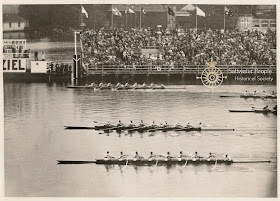 |
| Last home practice before heading east, to the Princeton trials. UW Crew, Lake Washington, 2 June 1936. |
Only once in the years of association could the shell builder, Mr. Pocock, recall the coach, Al Ulbrickson showing any emotion.That was after his Husky crew defeated an outstanding Penn crew at the Olympic qualifying finals in New Jersey:
"Al was as unemotional as ever during the race in which his crew won the right to represent the US at the Olympic Games in Berlin. Some time after the finish, he and I were walking back to the hotel. Suddenly he stopped, held out his hand and said, 'thanks, George, for your help.' Coming from Al, that was the equivalent of fireworks and a brass band." George Pocock.
After the UW victory at Princeton the team had one week before sailing on the steamship MANHATTAN, to Hamburg, en route to the Olympic Games. Their revered boatbuilder was with them.
By 'Nagronsky' of Skagit Valley, WA, adapted from Amazon.
"As a lifelong Husky fan, I was excited when I read the synopsis that this was about the 1936 University of Washington crew. I'd always been more familiar with the eight that won the 1948 World Championship over the USSR crew in Moscow but I love tales of 'small town' Seattle and the Great Generation, so I dove eagerly into it.
Although I've seen many races through Seattle's Montlake Cut, I never knew until reading this that crew races were formerly staged over 3 miles (rather than 2000 meters) on Lake Washington (and the Oakland estuary and the Hudson River), or that they ran north of Sand Point all the way to Sheridan Beach, or that viewing trains ran along the course from University Station on what is now the Burke-Gilman Trail (the former Seattle, Lake Shore and Eastern Railway). I'd never known that the famous shell builder, George Pocock, had won the Thames boatman's race (Doggett's Coat and Badge) before emigrating to Vancouver and Seattle with his brother.
I'd known for years (pre-'House') that actor Hugh Laurie had rowed for Cambridge, but was unaware that his father had also won his rowing Blue and rowed stroke oar there and on the 1936 England Olympic crew. Actually, Laurie didn't know until he found a medal among his father's socks. The coxswain on the Cambridge and England eight was John Noel Duckworth. When captured by the Japanese, Duckworth objected to his captors' treatment of his fellow prisoners who were wounded and offered that he himself be mistreated. He was a POW at Changoi Camp in Singapore, and then was moved to the Siam Railway project (think Bridge on the River Kwai). We Americans aren't the only people with a Greatest Generation.
Brown chooses to focus on one member of the UW crew who he happened to become acquainted with Joe Rantz, and Rantz's childhood, adolescence, and struggles to pay tuition are almost worthy of a single book. Rantz was able to endure his mother's death, being abandoned as a teen by his father and new wife, and muscling a jackhammer (while dangling from ropes) working the construction of the Grand Coulee Dam.
Once the UW crew and the Olympic team reaches Berlin, Brown gives more insights into life in and around mid-1930s Berlin, as well as into the disagreements between Joseph Goebbels and Leni Riefenstahl.
I really can't recommend this book highly enough. While I loved Seabiscuit, I'm not a horse racing fan. With Louie Zamperini's spiritual redemption in Unbroken, I could care less about Billy Graham, but loved this book. As regards The Boys in the Boat, as I said previously, this is not simply about the sport of rowing, but is so much more."
THE BOYS IN THE BOAT book search
The HUSKY CLIPPER can be seen on display at the University. Hail to the cast, who have all rowed on.
For the best historical documentation of Mr. George Pocock, the premier racing shell builder in the world, Gordon Newell has written the classic Ready All! George Yeoman Pocock and Crew Racing, University of Washington Press, 1987.
A new edition with a foreward by Dick Erickson including two cover photos from the Saltwater People Historical Society archives was published in 2015:
READY ALL book search











+1968.jpg)






